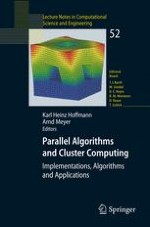2006 | OriginalPaper | Chapter
Localization of Electronic States in Amorphous Materials: Recursive Green’s Function Method and the Metal-Insulator Transition at E ≠ 0
Authors : Alexander Croy, Rudolf A. Römer, Michael Schreiber
Published in: Parallel Algorithms and Cluster Computing
Publisher: Springer Berlin Heidelberg
Activate our intelligent search to find suitable subject content or patents.
Select sections of text to find matching patents with Artificial Intelligence. powered by
Select sections of text to find additional relevant content using AI-assisted search. powered by
Traditionally, condensed matter physics has focused on the investigation of perfect crystals. However, real materials usually contain impurities, dislocations or other defects, which distort the crystal. If the deviations from the perfect crystalline structure are large enough, one speaks of
disordered systems
. The Anderson model [1] is widely used to investigate the phenomenon of localisation of electronic states in disordered materials and electronic transport properties in mesoscopic devices in general. Especially the occurrence of a quantum phase transition driven by disorder from an insulating phase, where all states are localised, to a metallic phase with extended states, has led to extensive analytical and numerical investigations of the critical properties of this metal-insulator transition (MIT) [2–4]. The investigation of the behaviour close to the MIT is supported by the one-parameter scaling hypothesis [5, 6]. This scaling theory originally formulated for the conductance plays a crucial role in understanding the MIT [7]. It is based on an ansatz interpolating between metallic and insulating regimes [8]. So far, scaling has been demonstrated to an astonishing degree of accuracy by numerical studies of the Anderson model [9–13]. However, most studies focused on scaling of the localisation length and the conductivity at the disorder-driven MIT in the vicinity of the band centre [9, 14, 15]. Assuming a power-law form for the d.c. conductivity, as it is expected from the one-parameter scaling theory, Villagonzalo et al. [6] have used the Chester-Thellung-Kubo-Greenwood formalism to calculate the temperature dependence of the thermoelectric properties numerically and showed that all thermoelectric quantities follow single-parameter scaling laws [16, 17].
